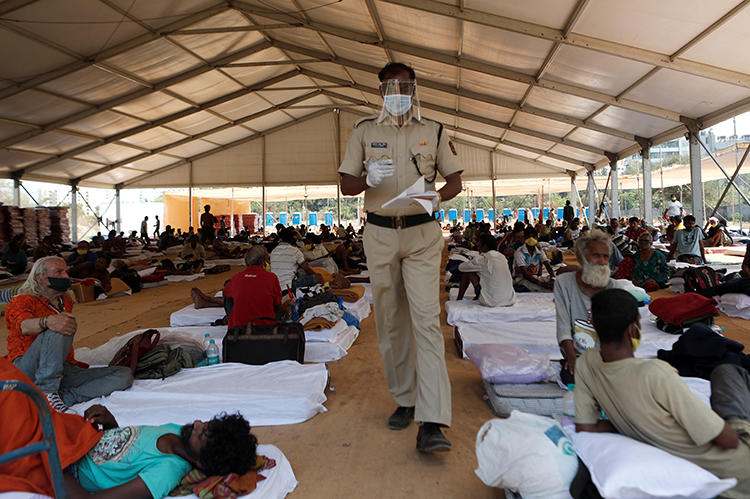On March 31, the Indian Supreme Court passed a directive making it compulsory for news outlets to carry the government’s official version on any news related to the COVID-19 pandemic.
The court ruled that media organizations are required to defer to the government version on the pandemic, and blamed “fake news” for recent migration from the country’s cities, according to reports.
CPJ spoke with Apar Gupta, a lawyer who has argued before the Supreme Court and who is the executive director of the Internet Freedom Foundation, a local digital rights group, about the ruling in a phone interview on April 4. This interview has been edited for length and clarity.
How concerned should Indian journalists be about the Supreme Court order on coronavirus coverage?
The Supreme Court order is of grave concern to press freedom, which has already come under increased challenges during the time of the coronavirus pandemic. There are directions contained within the order that require the press in India—which may be print, electronic, and even social media—to refer to the official government version [of events]. The order further references provisions of law under criminal prosecutions that can be launched against them [the journalists].
This brings a worrying level of oversight and power toward the government version, which can lead to instances of censorship when the reporting may not be favorable and may be in contrast to the “official government version” of events.
It is also important to examine this in the context of how the Indian government has been criticized by health reporters for not putting out timely reports of data concerning the coronavirus pandemic, especially in terms of numbers of people who have been administered tests, as well as those who have been placed under quarantine. It is worrying that in absence of proactive transparency, which would assist fact-based reporting, quite often, there will be a desire by the government to contour and shape the messaging of journalists towards its own version of events.
What do you think about the government’s explanation that ‘fake news’ made this decision necessary?
The fundamental premise of this direction arises from a submission by the government that it was fake news that led a large number of migrant laborers who wanted to return to their homes in far and distant villages [to move throughout the country].
Given that there was a pre-existing prohibition [on travel] and shortage of private as well as public modes of transport, many of them embarked on long and perilous journeys over hundreds of miles by foot. This was widely carried in the press and social media, which provides a background to this litigation.
In the order, the court notes that this migrant exodus from metropolitan cities occurred due to ‘fake news’ reports that suggested that the lockdown, which is imposed across the entire country, would stretch beyond the intended timeline announced by the prime minister to a period up to three months.
The basis of this determination by the court was that fake news was responsible for the migrant exodus, rather than migrant laborers’ inability to meet their daily needs due to the lockdown. [The fact] that a lot of the migrant laborers don’t have savings and rely on daily wages for their sustenance was not examined by the court.
The court has not taken into account the government’s lack of preparation and inadequacy in addressing this humanitarian crisis. This would have been in court’s knowledge, given that it was covered widely in mainstream newspapers and respectable publications.

The order says the court does “not intend to interfere with the free discussion about the pandemic, but direct the media [to] refer to and publish the official version about the developments.” How should this be interpreted?
While the court does note that they [the judges] do not intend to interfere with press reporting, there is an operative word, “but,” which it uses before it directs all the media to carry the government’s official version. It does not further contain much guidance, which makes this direction vague and thereby susceptible to arbitrary application.
The order also makes references to two underlying legal frameworks: firstly, under the National Disaster Management Act, and secondly under the Indian Penal Code, which would draw reference from the Epidemic Diseases Act. Both permit criminal prosecution, hence it seems that the court has also sought to criminalize what could be characterized as inaccurate reporting by repeated use of the words “fake news.”
What punishments could journalists face under those laws?
Under Section 54 of the Disaster Management Act, the punishment is only [decided] post-conviction. Given the long amount of trial, it is not the extent of the punishment which will matter, it is the prosecution itself.
This is the same position with regards to Section 188 [of the Indian Penal Code]. And there will be terms of imprisonment which will be prescribed post-sentencing, which may stretch for Section 188 up to six months, and up to one year for section 54 [of the Disaster Management Act].
The other thing that is also of concern here is that if one looks at it, the Epidemic Diseases Act under Section 2 permits the state government to formulate emergency orders and rules. The court has stated that [this includes] even advisories, which in the past take on the character of an order.
The issue is, an “advisory” is often extra-legal advice which does not follow from a clear statutory authority in favor of a public authority.
For instance, under the Epidemic Diseases Act, the [central] government doesn’t have the power to issue orders or formulate rules, the state governments do. However, in the Supreme Court order, there is a repeated reference to an advisory issued by the central government itself.
Such an advisory by the central government wouldn’t ordinarily lead to a prosecution under Section 188 [of the penal code] for defiance of a public order, however, the court has again not examined this issue.
So it needs to be considered that this order that has been passed without a careful degree of appreciation of the contours of free expression, and what value it serves during the times of a pandemic. And, the court has in fact accepted the government [request] for greater censorship powers as a need to contain rumor mongering and further social cohesion.
This is a clear choice that has been made by the court in favor of the government.
CPJ’s safety advisory for journalists covering the coronavirus outbreak is available in English and dozens of other languages. Additional CPJ coverage of the coronavirus can be found here.
